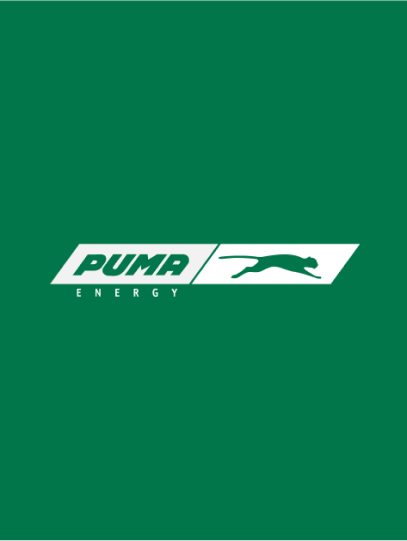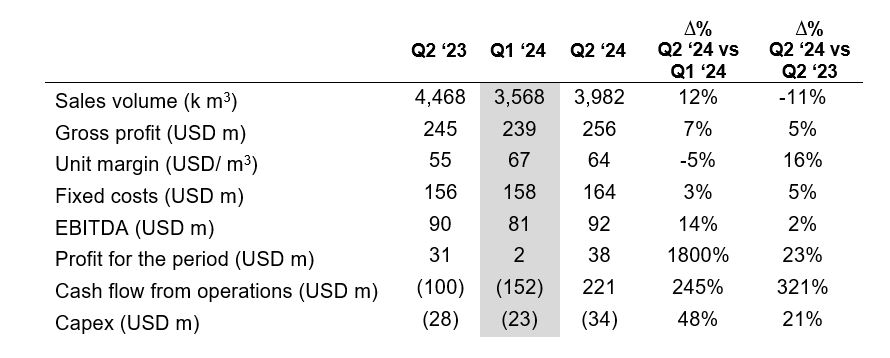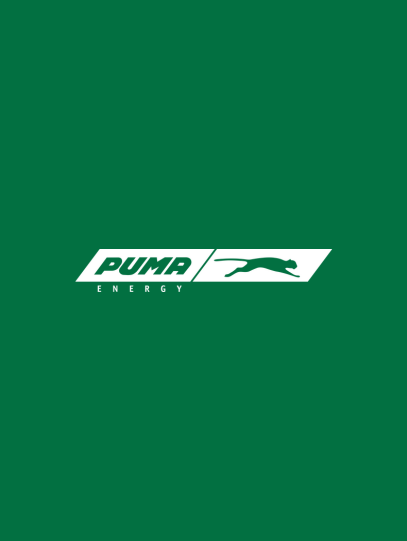
- Stable performance across core regions and segments
- Improved EBITDA, net profit and cash generation
Singapore, 22 August 2024 – Puma Energy today announced its financial results for the three-month period ending 30 June 2024.
The Company delivered a net profit of USD 38 million in Q2 2024, excluding the impacts of IFRS 16.
During the quarter, we achieved an EBITDA of USD 92 million, up from USD 81 million in Q1 2024. Our core regions and segments have demonstrated a stable performance, with continued growth in aviation year over year, and the recovery of margins and higher volumes across our commercial segment compared to Q1 2024.
The increase in net profit was driven by EBITDA performance as well as the sale of 85 percent of Puma Energy’s terminals in Vietnam. The positive cash flow from operations during Q2 2024 is linked to improvement in working capital, driven by normalization of fuel supply payables, higher collections of receivables and lower inventories.
Key Performance Indicators*

*NB All financial figures are presented excluding the impact of IFRS16
*Unadjusted for perimeter changes
“The business continues to deliver a stable performance with all our core regions and segments reporting an increase in gross profit this quarter versus Q1 and the same period last year.” said Carlos Pons, Chief Financial Officer of Puma Energy. “We remain prudent as we navigate the current global macroeconomic environment, which continues to be underpinned by higher cost of borrowing and economic stress in some of the countries we operate in Africa.”
“In June, we closed our 2024 Revolving Credit Facilities and Term Loan, which represent USD 775 million of commitments. This refinancing coupled with the recent successful issuance of 2029 Notes to repay 2024 Notes, significantly extends Puma Energy’s debt maturity profile from 1.5 years to 3.5 years demonstrating Puma Energy’s capacity to source medium-term liquidity. The support we received from our existing and new lenders reflects the improved confidence in our company’s future as we shift our focus from turning around the business to exploring prudent growth opportunities across our core downstream markets.”
Quarterly Highlights
Health and safety
The Lost Time Injury Frequency Rate for employees and contractors working on Puma Energy sites in the quarter was 1.14, which is an increase from last quarter. This is mainly attributed to changes in reporting culture across our business and a new reporting governance process. We continue our efforts to invest in training as well as strengthening our HSSE capabilities, procedures and standards.
Investment in Core Retail
Puma Energy continues to deliver on its strategy to expand its retail offering in core markets with a focus on non-fuel retail, including convenience stores and quick service restaurants, brand partnerships and improved customer experience. Puma Energy saw a net increase in retail sites of 36, of which 52 new sites were added to the portfolio and 16 non-performing sites were exited.
In Africa, we grew our network with 27 new retail sites, and exited eight non-performing sites, bringing the net total to 19 for the quarter. We continued with our refurbishment plans and forecourt upgrades as well as Quick Service Restaurant partnerships. Non-Fuel Retail stood at 5.1 percent of retail gross margin of our Africa business.
In Latin America, we added 25 retail stations to the network and exited six non-performing sites, bringing the net total to 19 for the quarter. We continue to deliver on our dual-brand strategy through our partnership with Shell and Texaco and added seven new Shell-branded stations in El Salvador and Honduras. Non-Fuel Retail stood at 21 percent of retail gross margin for the quarter, which shows our focus on this area is yielding positive results. Additionally, we continue to drive customer loyalty through our Puma PRIS app, which launched in Honduras in June. In Q2 the number of Puma PRIS users grew by 12 percent with a total of 1 million users.
Infrastructure divestment
In line with Puma Energy’s strategy to focus on its core downstream activities, the company completed the majority sale of its Vietnam storage assets which contributed USD 11.8 million to net profit.
Low Carbon and Renewable Energy
During the quarter, we installed additional solar power projects at 41 Puma Energy branded retail stations and sites bringing the collective total sites to 364.
Additionally, Puma Energy continues to build its offering of lower-carbon and renewable solutions to B2B customers in Africa. In June, Puma Energy kicked off construction of a 700 kWp Solar PV project for Alliance One in Tanzania.
As we begin to build a pipeline of B2B solar projects in Latin America, we have signed to deliver a 240 kWp solar project in Nicaragua and a 370kWp project that will generate 32 percent of the electricity for a food manufacturer in Honduras.
Capital Structure
Gross debt declined in Q2 versus Q1 mostly due to lower utilisation of our Opco debt and by reduction of our senior notes. A liability management exercise was conducted to repay $520 million of 2026 notes. The new $500 million bond issuance, maturing in 2029, was used to refinance a portion of these notes, supplemented by $20 million in cash from the company. Additionally, $3.5m of the 2026 notes were bought in the open market.
During Q2, Puma Energy repaid local Opco facilities, especially in Latin America thanks to our cash flow generation. Gross debt reduced from USD 1,083 million in Q1 down to USD 946 million in Q2.
Based on a standard definition of net debt, (net of cash and without inclusion of inventory), net debt stood at USD 581 million or 1.5 x LTM EBITDA, lower than 1.9x in Q1.
In April 2024, we issued a new USD 500 million 5NC2 bond maturing in 2029, enabling us to refinance a significant portion of our existing 2026 notes. Despite market volatility, the bond was oversubscribed, enabling Puma Energy to tighten the coupon, which was set at 7.75% at issuance.
In June 2024, we refinanced our 2023 Senior Facility Agreement. The new 2024 Senior Facility Agreement is divided into three main tranches: a 1-year revolving credit facility (RCF) amounting to USD 350 million, a 3-year RCF amounting to USD 150 million, and a 3-year term loan amounting to USD 275 million. As of the end of June 2024, the two RCF tranches remained unused, while the 3-year term loan was partially drawn to USD 175 million.
Consequently, as a result of the new bond issuance and RCF/term loan refinancing, Puma Energy extended its average maturity profile from 1.5 years to 3.5 years.
Key Performance Indicators Constant Perimeter*

*Q2 23 restated for Senegal Retail and LPG business, El Salvador (CEPA) terminal divestment and Tanzania Deconsolidation
– ENDS –
For investor queries, please contact:
Further information can be located at: Puma Energy: Investors: Overview
About Puma Energy
Puma Energy is a leading global downstream energy business, safely providing energy in more than 35 countries, primarily across central America and Sub-Saharan-Africa. Our downstream business segments include fuels, aviation, lubricants, LPG and bitumen. Our purpose is energising communities to help drive growth and prosperity by sustainably serving our customers’ needs in high potential countries around the world.
For further information visit: www.pumaenergy.com
Cautionary Statement
This announcement is not being made in and copies of it may not be distributed or sent into any jurisdiction where distribution would be unlawful.
Forward-looking statements
Some of the information included in this announcement contain forward-looking statements. You can identify these forward-looking statements by use of words such as “strategy,” “expects,” “continues,” “plans,” “anticipates,” “believes,” “will,” “estimates,” “intends,” “projects,” “goals,” “objectives,” “guidance,” “targets,” “forecasts” or “could”, the negative of such terms and other words of similar meaning. You can also identify them by the fact that they do not relate strictly to historical or current facts. Although Puma Energy believes that the assumptions upon which these forward-looking statements are based are reasonable, any of these assumptions could prove to be inaccurate and the forward-looking statements based on these assumptions could be incorrect. The matters discussed in these forward-looking statements are subject to risks, uncertainties and other factors that could cause actual results and trends to differ materially from those made, projected, or implied in or by the forward-looking statements depending on a variety of uncertainties or other factors. Accordingly, no representation or warranty, express or implied, is made or given by or on behalf of Puma Energy or any of its directors, officers or employees or any other person as to the accuracy, completeness or fairness of the information or opinions contained in this announcement. Accordingly, no representation or warranty, express or implied, is made or given by or on behalf of Puma Energy or any of its directors, officers or employees or any other person as to the accuracy, completeness or fairness of the information or opinions contained in this announcement.
